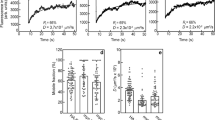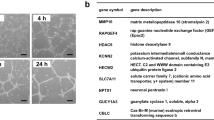Abstract
We have examined fibroblast growth factor (FGF) receptor-1 mediated signal transduction in differentiation of endothelial cells (EC). The activated FGFR-1 couples to Ras through two adaptor proteins, FRS2 and Shc. In FGF-2 treated proliferating EC, FRS2 as well as Shc are tyrosine phosphorylated and interact with Grb2. In contrast, in FGF-2 treated differentiating cells, Shc, but not FRS2, is engaged in Grb2-interactions. Sustained MAP kinase activity has previously been implicated in differentiation. In FGF stimulated proliferating and differentiating endothelial cells, the MAP kinase Erk2 is activated in a sustained manner. Inhibition of MEK and MAP kinase activity by PD98059 treatment of cells, still allows EC tube formation. The FGFR-1 mediates activation of protein kinase C (PKC) through direct binding and activation of phospholipase C-γ (PLC-γ), and has also been shown to activate the cytoplasmic tyrosine kinase Src. Treatment of the cells with the PKC inhibitor bisindolylmaleimide does not prevent tube formation. In contrast, Src kinase activity is a prerequisite for EC differentiation, since treatment of the cells with PP1, a Src family specific inhibitor, abrogates tube formation. In differentiating EC, FGF-2 induces complex formation between Src and focal adhesion kinase (FAK). These data indicate that the Ras pathway is initiated via Shc or FRS2, dependent on the cellular program. Blocking the function of Src family kinases, attenuates differentiation.
This is a preview of subscription content, access via your institution
Access options
Subscribe to this journal
Receive 50 print issues and online access
$259.00 per year
only $5.18 per issue
Buy this article
- Purchase on Springer Link
- Instant access to full article PDF
Prices may be subject to local taxes which are calculated during checkout









Similar content being viewed by others
References
Basilico C and Moscatelli D. . 1992 Adv. Cancer Res. 59: 115–165.
Burgess WH and Maciag T. . 1989 Annu. Rev. Biochem. 58: 575–606.
Cox AD and Der CJ. . 1997 Biochim. Biophys. Acta. 1333: F51–F71.
Eliceiri BP, Klemke R, Stromblad S and Cheresh DA. . 1998 J. Cell Biol. 140: 1255–1263.
Folkman J. . 1986 Cancer Res. 46: 467–473.
Folkman J and Klagsbrun M. . 1987 Science 235: 442–447.
Gotoh N, Tojo A and Shibuya M. . 1996 EMBO J. 15: 6197–6204.
Haklai R, Weisz MG, Elad G, Paz A, Marciano D, Egozi Y, Ben-Baruch G and Kloog Y. . 1998 Biochemistry 37: 1306–1314.
Hanke JH, Gardner JP, Dow RL, Changelian PS, Brissette WH, Weringer EJ, Pollok BA and Connelly PA. . 1996 J. Biol. Chem. 271: 695–701.
Hara M, Akasaka K, Akinaga S, Okabe M, Nakano H, Gomez R, Wood D, Uh M and Tamanoi F. . 1993 Proc. Natl. Acad. Sci. USA 90: 2281–2285.
Howe LR, Leevers SJ, Gomez N, Nakielny S, Cohen P and Marshall CJ. . 1992 Cell 71: 335–342.
Jaye M, Schlessinger J and Dionne CA. . 1992 Biochim. Biophys. Acta. 1135: 185–199.
Johnson DE and Williams LT. . 1993 Adv. Cancer Res. 60: 1–41.
Kanda S, Landgren E, Ljungstrom M and Claesson-Welsh L. . 1996 Cell Growth Differ. 7: 383–395.
Kanda S, Tomasini-Johansson B, Klint P, Rubin K and Claesson-Welsh L . 1999 Exp. Cell. Res. In press.
Kim HA, Ling B and Ratner N. . 1997 Mol. Cell Biol. 17: 862–872.
Klint P, Kanda S and Claesson-Welsh L. . 1995 J. Biol. Chem. 270: 23337–23344.
Kolch W, Heidecker G, Kochs G, Hummel R, Vahidi H, Mischak H, Finkenzeller G, Marme D and Rapp UR. . 1993 Nature 364: 249–252.
Kosako H, Nishida E and Gotoh Y. . 1993 EMBO J. 12: 787–794.
Kouhara H, Hadari YR, Spivak-Kroizman T, Schilling J, Bar-Sagi D, Lax I and Schlessinger J. . 1997 Cell 89: 693–702.
Kremer NE, D'Arcangelo G, Thomas SM, DeMarco M, Brugge JS and Halegoua S. . 1991 J. Cell Biol. 115: 809–819.
Kuo WL, Chung KC and Rosner MR. . 1997 Mol. Cell Biol. 17: 4633–4643.
Landgren E, Blume-Jensen P, Courtneidge SA and Claesson-Welsh L. . 1995 Oncogene 10: 2027–2035.
Leevers SJ and Marshall CJ. . 1992 EMBO J. 11: 569–574.
Marshall CJ. . 1995 Cell 80: 179–185.
Matthews JA, Batki A, Hynds C and Kricka LJ. . 1985 Anal. Biochem. 151: 205–209.
Meloche S, Seuwen K, Pages G and Pouyssegur J. . 1992 Mol. Endocrinol. 6: 845–854.
Mohammadi M, Dikic I, Sorokin A, Burgess WH, Jaye M and Schlessinger J. . 1996 Mol. Cell Biol. 16: 977–989.
Mohammadi M, Dionne CA, Li W, Li N, Spivak T, Honegger AM, Jaye M and Schlessinger J. . 1992 Nature 358: 681–684.
Moodie SA, Willumsen BM, Weber MJ and Wolfman A. . 1993 Science 260: 1658–1661.
Nagase T, Kawata S, Tamura S, Matsuda Y, Inui Y, Yamasaki E, Ishiguro H, Ito T and Matsuzawa Y. . 1996 Int. J. Cancer 65: 620–626.
Pawson T. . 1995 Nature 373: 573–580.
Pelicci G, Lanfrancone L, Grignani F, McGlade J, Cavallo F, Forni G, Nicoletti I, Grignani F, Pawson T and Pelicci PG. . 1992 Cell 70: 93–104.
Peters KG, Marie J, Wilson E, Ives HE, Escobedo J, Del Rosario M, Mirda D and Williams LT. . 1992 Nature 358: 678–681.
Plopper GE, McNamee HP, Dike LE, Bojanowski K and Ingber DE. . 1995 Mol. Biol. Cell 6: 1349–1365.
Schaller MD, Hildebrand JD, Shannon JD, Fox JW, Vines RR and Parsons JT. . 1994 Mol. Cell Biol. 14: 1680–1688.
Schlaepfer DD, Hanks SK, Hunter T and van der Geer P. . 1994 Nature 372: 786–791.
Schlaepfer DD, Jones KC and Hunter T. . 1998 Mol. Cell Biol. 18: 2571–2585.
Stokoe D and McCormick F. . 1997 EMBO J. 16: 2384–2396.
Thomas SM, Soriano P and Imamoto A. . 1995 Nature 376: 267–271.
Toullec D, Pianetti P, Coste H, Bellevergue P, Grand-Perret T, Ajakane M, Baudet V, Boissin P, Boursier E, Loriolle F, Duhamel L, Charon D and Kirilovsky J. . 1991 J. Biol. Chem. 266: 15771–15781.
Traverse S, Seedorf K, Paterson H, Marshall CJ, Cohen P and Ullrich A. . 1994 Curr. Biol. 4: 694–701.
Twamley-Stein GM, Pepperkok R, Ansorge W and Courtneidge SA. . 1993 Proc. Natl. Acad. Sci. USA 90: 7696–7700.
Vaillancourt RR, Heasley LE, Zamarripa J, Storey B, Valius M, Kazlauskas A and Johnson GL. . 1995 Mol. Cell Biol. 15: 3644–3653.
Xing Z, Chen HC, Nowlen JK, Taylor SJ, Shalloway D and Guan JL. . 1994 Mol. Biol. Cell 5: 413–421.
Yamauchi K and Pessin JE. . 1994 J. Biol. Chem. 269: 31107–31114.
Acknowledgements
We thank Dr Lars Rönnstrand for the ERK2 antiserum, Dr Roya Hooshmand-Rad for the Src antiserum, Dr Joseph Schlessinger for the GST – Grb2 SH2 fusion protein, Dr Mitsunobu Hara for manumycin, Drs Carl-Henrik Heldin and Pär Gerwins for helpful comments and Charlotte Wikner for expert technical assistance. This work was supported by a grant to Lena Claesson-Welsh from the Swedish Cancer Society (3820-B97-02XBB).
Author information
Authors and Affiliations
Rights and permissions
About this article
Cite this article
Klint, P., Kanda, S., Kloog, Y. et al. Contribution of Src and Ras pathways in FGF-2 induced endothelial cell differentiation. Oncogene 18, 3354–3364 (1999). https://doi.org/10.1038/sj.onc.1202680
Received:
Revised:
Accepted:
Published:
Issue Date:
DOI: https://doi.org/10.1038/sj.onc.1202680
Keywords
This article is cited by
-
Fibroblast growth factor-2 stimulates proliferation of human adipose-derived stem cells via Src activation
Stem Cell Research & Therapy (2019)
-
Molecular interactions in juvenile nasopharyngeal angiofibroma: preliminary signature and relevant review
European Archives of Oto-Rhino-Laryngology (2019)
-
High-throughput transcriptome analysis reveals that the loss of Pten activates a novel NKX6-1/RASGRP1 regulatory module to rescue microphthalmia caused by Fgfr2-deficient lenses
Human Genetics (2019)
-
Role of Neurotrophic Factor Alterations in the Neurodegenerative Process in HIV Associated Neurocognitive Disorders
Journal of Neuroimmune Pharmacology (2014)
-
Basic Fibroblast Growth Factor (bFGF) Facilitates Differentiation of Adult Dorsal Root Ganglia-Derived Neural Stem Cells Toward Schwann Cells by Binding to FGFR-1 Through MAPK/ERK Activation
Journal of Molecular Neuroscience (2014)



